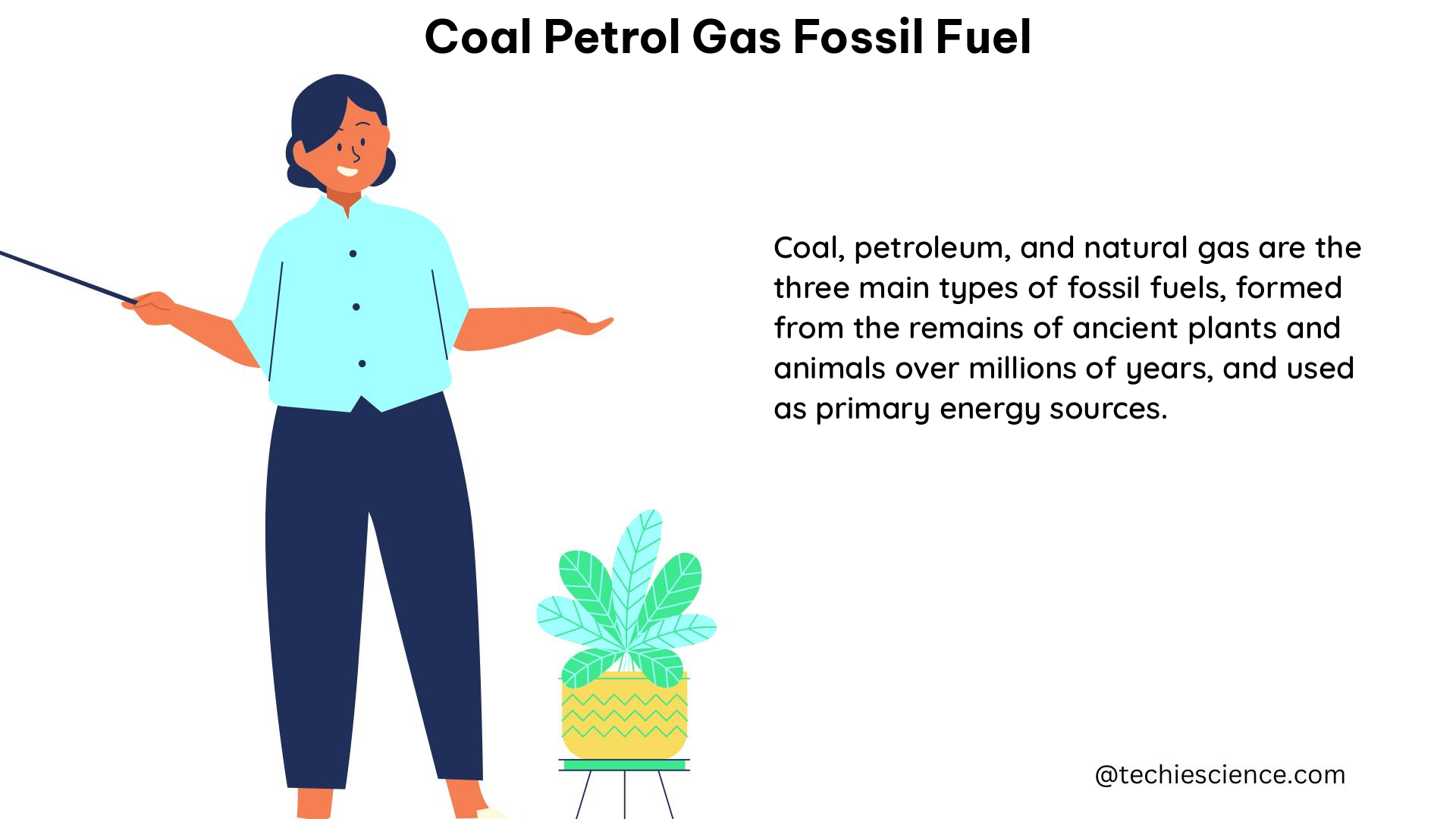Fossil fuels, including coal, petrol, and natural gas, are the primary sources of energy that have powered the world’s economies for centuries. Understanding the reserves, consumption, production, and environmental impact of these fuels is crucial for energy planning, policy-making, and addressing the challenges of climate change. This comprehensive guide delves into the measurable and quantifiable data on coal, petrol, and gas fossil fuels, providing a detailed and technical resource for physics students and enthusiasts.
Coal Reserves and Consumption
Proven Coal Reserves
The distribution of proven coal reserves across the world is uneven, with some regions having significantly larger reserves than others. According to the interactive chart on Our World in Data, the top countries with the largest proven coal reserves are:
- United States: 249.5 billion metric tons
- Russia: 162.1 billion metric tons
- China: 139.0 billion metric tons
- Australia: 147.4 billion metric tons
- India: 106.1 billion metric tons
These reserves are estimated based on geological surveys and economic feasibility assessments, and they represent the amount of coal that can be extracted and utilized with current technology and economic conditions.
Coal Consumption
In the United States, the consumption of coal has declined significantly over the past few decades. In 1950, coal accounted for approximately 36% of the total energy consumption in the country. However, by 2022, this figure had dropped to around 10%. The peak consumption of coal in the U.S. was recorded in 2005, reaching about 22.80 quads (quadrillion British thermal units).
The decline in coal consumption can be attributed to several factors, including the increasing competitiveness of natural gas and renewable energy sources, as well as stricter environmental regulations and policies aimed at reducing greenhouse gas emissions.
Gas Reserves and Consumption

Proven Gas Reserves
Similar to coal, the distribution of proven natural gas reserves across the world is also uneven. The interactive chart on Our World in Data shows the top countries with the largest proven natural gas reserves:
- Russia: 37.4 trillion cubic meters
- Iran: 32.1 trillion cubic meters
- Qatar: 24.7 trillion cubic meters
- Turkmenistan: 13.6 trillion cubic meters
- United States: 12.9 trillion cubic meters
These proven reserves represent the estimated amount of natural gas that can be extracted and utilized with current technology and economic conditions.
Gas Consumption
In the United States, the consumption of natural gas has increased significantly over the past few decades. In 1950, natural gas accounted for approximately 17% of the total energy consumption in the country. By 2022, this figure had risen to around 33%, with a consumption of about 33.41 quads.
The increased consumption of natural gas can be attributed to several factors, including the development of new extraction techniques (such as hydraulic fracturing and horizontal drilling), the abundance of domestic natural gas resources, and the relatively lower greenhouse gas emissions of natural gas compared to other fossil fuels.
Fossil Fuel Consumption and Production
Total U.S. Energy Production
In 2022, the total annual energy production in the United States was 102.92 quads, exceeding the total annual energy consumption of 100.41 quads. This indicates that the U.S. is a net exporter of energy, with the potential to meet its domestic energy needs and contribute to the global energy market.
Fossil Fuel Share in U.S. Energy Production
Fossil fuels, including petroleum, natural gas, and coal, accounted for approximately 81% of the total U.S. primary energy production in 2022. This highlights the continued reliance on fossil fuels as the dominant energy sources in the country.
Primary Energy Sources in the U.S.
The percentage shares and amounts (in quads) of total U.S. primary energy production by major sources in 2022 were:
| Energy Source | Percentage Share | Amount (quads) |
|---|---|---|
| Natural Gas | 36% | 37.10 |
| Petroleum (crude oil and natural gas plant liquids) | 31% | 32.33 |
| Renewable Energy | 13% | 13.40 |
| Coal | 12% | 12.04 |
| Nuclear Electric Power | 8% | 8.05 |
This data demonstrates the diversification of the U.S. energy mix, with natural gas and petroleum remaining the primary sources, while renewable energy and nuclear power are gaining a more significant share.
Fossil Fuel Emissions and Global Warming
CO2 Emissions
The burning of fossil fuels, including coal, petrol, and natural gas, is a major contributor to the release of carbon dioxide (CO2) into the atmosphere. The amount of CO2 produced from fossil fuel burning is calculated from economic inventories and atmospheric measurements. Roughly half of the CO2 from fossil fuel burning stays in the atmosphere, contributing to the greenhouse effect and global warming.
The Keeling Curve, a graph of atmospheric CO2 concentrations measured at the Mauna Loa Observatory in Hawaii, shows a steady increase in CO2 levels over time, with a strong correlation to the increasing global consumption of fossil fuels.
Energy Released from Fossil Fuels
The burning of fossil fuels releases a significant amount of energy, which has been a driving force behind the industrialization and economic development of many countries. However, the energy released from fossil fuels is not directly measurable as a change to global energy content.
According to the Earth Science Stack Exchange, the human primary non-renewable energy consumption is estimated to be around 15 terawatts (TW). This energy consumption, while contributing to global warming, does not directly impact the overall energy content of the Earth’s system, as the energy is primarily released in the form of heat and is eventually radiated into space.
References
- Ritchie, H., & Rosado, P. (2017). Fossil fuels. Our World in Data. Retrieved from: https://ourworldindata.org/fossil-fuels
- NOAA Global Monitoring Laboratory. (n.d.). Isotopes: The Data. Retrieved from: https://gml.noaa.gov/ccgg/isotopes/c14tellsus.html
- Earth Science Stack Exchange. (2016). Does the amount of energy released from burning of fossil fuels have a measurable impact on global warming? Retrieved from: https://earthscience.stackexchange.com/questions/8103/does-the-amount-of-energy-released-from-burning-of-fossil-fuels-have-a-measurabl
- Quizlet. (n.d.). Fossil fuels (coal, petroleum, natural gas) Flashcards. Retrieved from: https://quizlet.com/738038442/fossil-fuels-coal-petroleum-natural-gas-flash-cards/
- U.S. Energy Information Administration. (n.d.). U.S. energy facts explained – consumption and production. Retrieved from: https://www.eia.gov/energyexplained/us-energy-facts/

I am Subrata, Ph.D. in Engineering, more specifically interested in Nuclear and Energy science related domains. I have multi-domain experience starting from Service Engineer for electronics drives and micro-controller to specialized R&D work. I have worked on various projects, including nuclear fission, fusion to solar photovoltaics, heater design, and other projects. I have a keen interest in the science domain, energy, electronics and instrumentation, and industrial automation, primarily because of the wide range of stimulating problems inherited to this field, and every day it’s changing with industrial demand. Our aim here is to exemplify these unconventional, complex science subjects in an easy and understandable to the point manner.